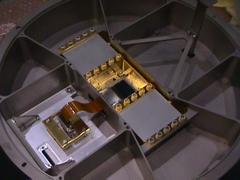Optics

The XRT consists of the X-ray and visible light optics, focal plane mechanisms (filters and shutter), and the 2k × 2k CCD camera. The optical systems form X-ray and visible light images on a common CCD. The optics are similar to those of Soft X-ray Telescope (SXT) on board Yohkoh.
Detector
 The XRT uses a back-illuminated three-phase CCD with 13.5 micron pixel-size and 2048 × 2048 array, which was manufactured by E2V Technologies. The CCD will be operated under -43 C on the orbit. Camera performances (mostly measured) are presented in Fact Sheet.
The XRT uses a back-illuminated three-phase CCD with 13.5 micron pixel-size and 2048 × 2048 array, which was manufactured by E2V Technologies. The CCD will be operated under -43 C on the orbit. Camera performances (mostly measured) are presented in Fact Sheet.
A unique feature of XRT is that the CCD is mounted on an adjustable (by command from the ground) stage with stroke of ± 1 mm along the optical axis, while maintaining the stringent cooling requirement. This eliminates the risk of defocus in orbit, which would otherwise be difficult to overcome given the size and the complexity of the X-ray telescope. This design was driven by consideration of risk mitigation. However, this can be used in the scientific operation. Image plane of the grazing incidence optics is heavily curved, and the focus adjustment allows us to choose either on-axis maximum resolution with rapid off-axis degradation (Gaussian focus) or the focus position that gives resolution as uniform as possible over a larger field-of-view.
XRT can take partial frame images for higher cadence. The horizontal and vertical size of the partial frame images are 64, 128, 192, 256, 384, 512, 768, 1024, 1536 and 2048 pixels. We select not only a square-shaped but also a rectangular-shaped partial frame image (ex. 1024 × 256, 256 × 512). Size of 64 pixels is, however, used only for square images (64 × 64). If the spacecraft is pointed to the center of the solar disk, the largest field-of-view (2048 × 2048 pixel = 34' × 34') can cover the full solar disk.
